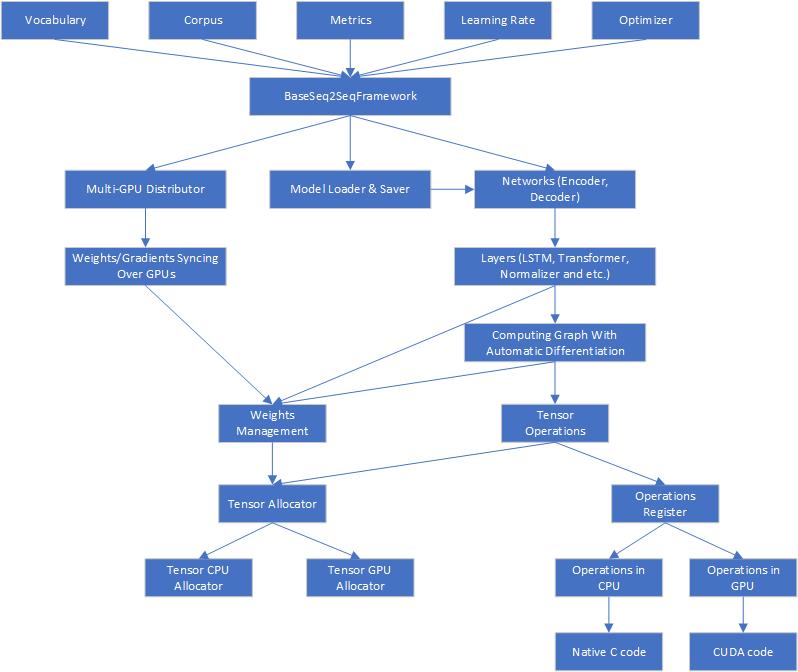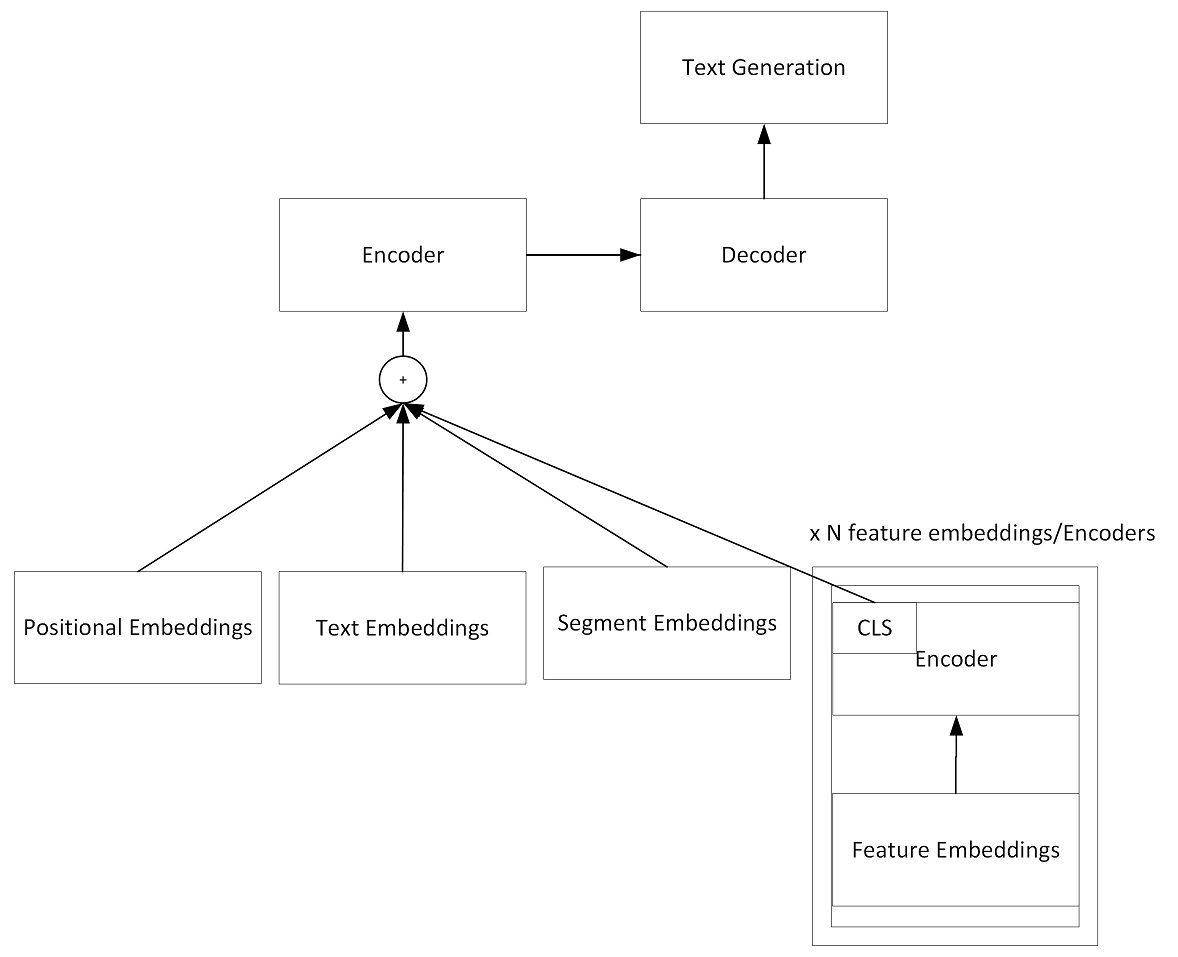Donate a beverage to help me to keep Seq2SeqSharp up to date :) 
Seq2SeqSharp
Seq2SeqSharp is a tensor based fast & flexible deep neural network framework written by .NET (C#). It can be used for sequence-to-sequence task, sequence-labeling task, sequence-classification task and others for text and images. Seq2SeqSharp supports both CPUs and GPUs and is able to run cross-platforms, such as Windows and Linux (x86, x64 and ARM) without any modification and recompilation.
Features
Pure C# framework
Transformer encoder and decoder with pointer generator
Vision Transformer encoder for images
GPTDecoder
Attention based LSTM decoder with coverage model
Bi-directional LSTM encoder
Support multi-platforms, such as Windows, Linux, MacOS and others
Support multi-architecture, such as X86, X64 and ARM
Built-in several networks for sequence-to-sequence, sequence-classification, labeling and similarity tasks
Mixture of Experts network that could easily train huge model with less computing cost
Support Automatic Mixed Precesion (FP16)
Built-in SentencePiece supported
Rotary Positional Embeddings
Layer Norm and RMS Norm
Python package supported
Tags embeddings mechanism
Prompted Decoders
Include console tools and web apis for built-in networks
Graph based neural network
Automatic differentiation
Tensor based operations
Running on both CPUs (Supported by Intel MKL) and multi-GPUs (CUDA)
Optimized CUDA memory management for higher performance
Different Text Generation Strategy: ArgMax, Beam Search, Top-P Sampling
RMSProp and Adam optmization
Embedding & Pre-trained model
Built-in metrics and extendable, such as BLEU, Length ratio, F1 score and so on
Attention alignment generation between source side and target side
ProtoBuf serialized model
Visualize neural network
Architecture
Here is the architecture of Seq2SeqSharp

Seq2SeqSharp provides the unified tensor operations, which means all tensor operations running on CPUs and GPUs are completely same and they can get switched on different device types without any modification.
Seq2SeqSharp is also a framework that neural networks can run on multi-GPUs in parallel. It can automatically distribute/sync weights/gradients over devices, manage resources and models and so on, so developers are able to totally focus on how to design and implment networks for their tasks.
Seq2SeqSharp is built by (.NET core)[https://docs.microsoft.com/en-us/dotnet/core/], so it can run on both Windows and Linux without any modification and recompilation.
Usage
Seq2SeqSharp provides some command line tools that you can run for different types of tasks.
| Name | Comments |
|---|---|
| Seq2SeqConsole | Used for sequence-to-sequence tasks, such as machine translation, automatic summarization and so on |
| SeqClassificationConsole | Used for sequence classification tasks, such as intention detection. It supports multi-tasks, which means a single model can be trained or tested by multi-classification tasks |
| SeqLabelConsole | Used for sequence labeling tasks, such as named entity recongizer, postag and other |
| GPTConsole | Used to train and test GPT type models. It can be used for any text generation tasks. |
It also provides web service APIs for above tasks.
| Name | Comments |
|---|---|
| SeqWebAPIs | Web Service RESTful APIs for many kinds of sequence tasks. It hosts models trained by Seq2SeqSharp and infer online. |
| SeqWebApps | Web application for sequence-to-sequence or GPT models. |
Seq2SeqConsole for sequence-to-sequence task
Here is the graph that what the model looks like:

You can use Seq2SeqConsole tool to train, test and visualize models.
Here is the command line to train a model:
Seq2SeqConsole.exe -Task Train [parameters...]
Parameters:
-SrcEmbeddingDim: The embedding dim of source side. Default is 128
-TgtEmbeddingDim: The embedding dim of target side. Default is 128
-HiddenSize: The hidden layer dim of encoder and decoder. Default is 128
-LearningRate: Learning rate. Default is 0.001
-EncoderLayerDepth: The network depth in encoder. The default depth is 1.
-DecoderLayerDepth: The network depth in decoder. The default depth is 1.
-EncoderType: The type of encoder. It supports BiLSTM and Transformer.
-DecoderType: The type of decoder. It supports AttentionLSTM and Transformer.
-MultiHeadNum: The number of multi-heads in Transformer encoder and decoder.
-ModelFilePath: The model file path for training and testing.
-SrcVocab: The vocabulary file path for source side.
-TgtVocab: The vocabulary file path for target side.
-SrcLang: Source language name.
-TgtLang: Target language name.
-TrainCorpusPath: training corpus folder path
-ValidCorpusPath: valid corpus folder path
-GradClip: The clip gradients.
-BatchSize: Batch size for training. Default is 1.
-ValBatchSize: Batch size for testing. Default is 1.
-ExpertNum: The number of experts in MoE (Mixture of Expert) model. Default is 1.
-Dropout: Dropout ratio. Defaul is 0.1
-ProcessorType: Processor type: CPU or GPU(Cuda)
-DeviceIds: Device ids for training in GPU mode. Default is 0. For multi devices, ids are split by comma, for example: 0,1,2
-TaskParallelism: The max degress of parallelism in task. Default is 1
-MaxEpochNum: Maxmium epoch number during training. Default is 100
-MaxSrcSentLength: Maxmium source sentence length on training and test set. Default is 110 tokens
-MaxTgtSentLength: Maxmium target sentence length on training and test set. Default is 110 tokens
-MaxValidSrcSentLength: Maxmium source sentence length on valid set. Default is 110 tokens
-MaxValidTgtSentLength: Maxmium target sentence length on valid set. Default is 110 tokens
-WarmUpSteps: The number of steps for warming up. Default is 8,000
-EnableTagEmbeddings: Enable tag embeddings in encoder. The tag embeddings will be added to token embeddings. Default is false
-CompilerOptions: The options for CUDA NVRTC compiler. Options are split by space. For example: "--use_fast_math --gpu-architecture=compute_60" means to use fast math libs and run on Pascal and above GPUs
-Optimizer: The weights optimizer during training. It supports Adam and RMSProp. Adam is default
-CompilerOptions: The NVRTC compiler options for GPUs. --include-path is required to point to CUDA SDK include path.
Note that if "-SrcVocab" and "-TgtVocab" are empty, vocabulary will be built from training corpus.
Example: Seq2SeqConsole.exe -Task Train -SrcEmbeddingDim 512 -TgtEmbeddingDim 512 -HiddenSize 512 -LearningRate 0.002 -ModelFilePath seq2seq.model -TrainCorpusPath .\corpus -ValidCorpusPath .\corpus_valid -SrcLang ENU -TgtLang CHS -BatchSize 256 -ProcessorType GPU -EncoderType Transformer -EncoderLayerDepth 6 -DecoderLayerDepth 2 -MultiHeadNum 8 -DeviceIds 0,1,2,3,4,5,6,7
During training, the iteration information will be printed out and logged as follows:
info,9/26/2019 3:38:24 PM Update = '15600' Epoch = '0' LR = '0.002000', Current Cost = '2.817434', Avg Cost = '3.551963', SentInTotal = '31948800', SentPerMin = '52153.52', WordPerSec = '39515.27'
info,9/26/2019 3:42:28 PM Update = '15700' Epoch = '0' LR = '0.002000', Current Cost = '2.800056', Avg Cost = '3.546863', SentInTotal = '32153600', SentPerMin = '52141.86', WordPerSec = '39523.83'
Here is the command line to valid models
Seq2SeqConsole.exe -Task Valid [parameters...]
Parameters:
-ModelFilePath: The trained model file path.
-SrcLang: Source language name.
-TgtLang: Target language name.
-ValidCorpusPath: valid corpus folder path
Example: Seq2SeqConsole.exe -Task Valid -ModelFilePath seq2seq.model -SrcLang ENU -TgtLang CHS -ValidCorpusPath .\corpus_valid
Here is the command line to test models
Seq2SeqConsole.exe -Task Test [parameters...]
Parameters:
-InputTestFile: The input file for test.
-OutputFile: The test result file.
-OutputPromptFile: The prompt file for output. It is a input file along with input test file.
-OutputAlignmentsFile: The output file that contains alignments between target sequence and source sequence. It only works for pointer-generator enabled model.
-ModelFilePath: The trained model file path.
-ProcessorType: Architecture type: CPU or GPU
-DeviceIds: Device ids for training in GPU mode. Default is 0. For multi devices, ids are split by comma, for example: 0,1,2
-BeamSearchSize: Beam search size. Default is 1
-MaxSrcSentLength: Maxmium source sentence length on valid/test set. Default is 110 tokens
-MaxTgtSentLength: Maxmium target sentence length on valid/test set. Default is 110 tokens
Example: Seq2SeqConsole.exe -Task Test -ModelFilePath seq2seq.model -InputTestFile test.txt -OutputFile result.txt -ProcessorType CPU -BeamSearchSize 5 -MaxSrcSentLength 100 -MaxTgtSentLength 100
You can also keep all parameters into a json file and run Seq2SeqConsole.exe -ConfigFilePath <config_file_path> Here is an example for training.
{ "DecoderLayerDepth": 6, "DecoderStartLearningRateFactor": 1.0, "DecoderType": "Transformer", "EnableCoverageModel": false, "IsDecoderTrainable": true, "IsSrcEmbeddingTrainable": true, "IsTgtEmbeddingTrainable": true, "MaxValidSrcSentLength": 110, "MaxValidTgtSentLength": 110, "MaxSrcSentLength": 110, "MaxTgtSentLength": 110, "SeqGenerationMetric": "BLEU", "SharedEmbeddings": true, "TgtEmbeddingDim": 512, "PointerGenerator": true, "BatchSize": 64, "MaxTokenSizePerBatch": 5120, "BeamSearchSize": 1, "Beta1": 0.9, "Beta2": 0.98, "CompilerOptions": "--use_fast_math --gpu-architecture=compute_70 --include-path=<CUDA SDK Include Path>", "ConfigFilePath": "", "DecodingStrategy": "GreedySearch", "DecodingRepeatPenalty": 2.0, "DeviceIds": "0", "DropoutRatio": 0.0, "EnableSegmentEmbeddings": false, "ExpertNum": 1, "ExpertsPerTokenFactor": 1, "MaxSegmentNum": 16, "EncoderLayerDepth": 6, "SrcEmbeddingDim": 512, "EncoderStartLearningRateFactor": 1.0, "EncoderType": "Transformer", "FocalLossGamma": 0.0, "GradClip": 5.0, "HiddenSize": 512, "IntermediateSize": 2048, "IsEncoderTrainable": true, "LossType": "CrossEntropy", "MaxEpochNum": 100, "MemoryUsageRatio": 0.99, "ModelFilePath": "mt_enu_chs.model", "MultiHeadNum": 8, "NotifyEmail": "", "Optimizer": "Adam", "ProcessorType": "GPU", "MKLInstructions": "AVX2", "SrcLang": "SRC", "StartLearningRate": 0.0006, "PaddingType": "NoPadding", "Task": "Train", "TooLongSequence": "Ignore", "ActivateFunc": "SiLU", "LearningRateType": "CosineDecay", "PEType": "RoPE", "NormType": "LayerNorm", "LogVerbose": "Normal", "TgtLang": "TGT", "TrainCorpusPath": ".\\data\\train", "ValidCorpusPaths": ".\\data\\valid", "SrcVocab": null, "TgtVocab": null, "TaskParallelism": 1, "UpdateFreq": 2, "ValMaxTokenSizePerBatch": 500, "StartValidAfterUpdates": 10000, "RunValidEveryUpdates": 10000, "WarmUpSteps": 8000, "WeightsUpdateCount": 0, "SrcVocabSize": 45000, "TgtVocabSize": 45000, "EnableTagEmbeddings": false }
Data Format for Seq2SeqConsole tool
The training/valid corpus contain each sentence per line. The file name pattern is "mainfilename.{source language name}.snt" and "mainfilename.{target language name}.snt".
For example: Let's use three letters name CHS for Chinese and ENU for English in Chinese-English parallel corpus, so we could have these corpus files: train01.enu.snt, train01.chs.snt, train02.enu.snt and train02.chs.snt.
In train01.enu.snt, assume we have below two sentences:
the children huddled together for warmth .
the car business is constantly changing .
So, train01.chs.snt has the corresponding translated sentences:
孩子 们 挤 成 一 团 以 取暖 .
汽车 业 也 在 不断 地 变化 .
To apply contextual features, you can append features to the line of input text and split them by tab character.
Here is an example. Let's assume we have a translation model that can translate English to Chinese, Japanese and Korean, so given a English sentence, we need to apply a contextual feature to let the model know which language it should translate to.
In train01.enu.snt, the input will be changed to:
the children huddled together for warmth . \t CHS
the car business is constantly changing . \t CHS
But train01.cjk.snt is the same as train01.chs.snt in above.
孩子 们 挤 成 一 团 以 取暖 .
汽车 业 也 在 不断 地 变化 .
Prompt decoding
Beside decoding entire sequence from the scratch, Seq2SeqConsole also supports to decode sequence by given prompts.
Here is an example of machine translation model from English to CJK (Chinese, Japanese and Korean). This single model is able to translate sentence from English to any CJK language. The input sentence is normal English, and then you give the decoder a prompt for translation.
For example: given the input sentence "▁i ▁would ▁like ▁to ▁drink ▁with ▁you ." (Note that it has been tokenized by sentence piece model) and different prompt for decoder, the model will translate it to different languages.
| Prompt | Translated Sentence |
|---|---|
| <CHS> | <CHS> ▁我想 和你一起 喝酒 。 |
| <JPN> | <JPN> ▁ あなたと 飲み たい |
| <KOR> | <KOR> ▁나는 ▁당신과 ▁함께 ▁마시 길 ▁바랍니다 . |
GPTConsole for GPT decoder only model training and testing
GPTConsole is a command line tool for GPT style model training and testing. Given text in input file per line, the model will continue generating the rest of text.
This tool is pretty similiar to Seq2SeqConsole and most of parameters are reusable. The main difference is that GPTConsole does not have settings for source side and encoders. Its all settings are for target side and decoder only.
ImgSeqConsole is for image caption task
ImgSeqConsole is a command line tool for image caption task. Given a list of image file path, the model will generate descriptions of these images.
SeqClassification for sequence-classification task
SeqClassification is used to classify input sequence to a certain category. Given an input sequence, the tool will add a [CLS] tag at the beginning of sequence, and then send it to the encoder. At top layer
编辑推荐精选


Vora
免费创建高清无水印Sora视频
Vora是一个免费创建高清无水印Sora视频的AI工具


Refly.AI
最适合小白的AI自动化工作流平台
无需编码,轻松生成可复用、可变现的AI自动化工作流


酷表ChatExcel
大模型驱动的Excel数据处理工具
基于大模型交互的表格处理系统,允许用户通过对话方式完成数据整理和可视化分析。系统采用机器学习算法解析用户指令,自动执行排序、公式计算和数据透视等操作,支持多种文件格式导入导出。数据处理响应速度保持在0.8秒以内,支持超过100万行数据的即时分析。


TRAE编程
AI辅助编程,代码自动修复
Trae是一种自适应的集成开发环境(IDE),通过自动化和多元协作改变开发流程。利用Trae,团队能够更快速、精确地编写和部署代码,从而提高编程效率和项目交付速度。Trae具备上下文感知和代码自动完成功能,是提升开发效率的理想工具。


AIWritePaper论文写作
AI论文写作指导平台
AIWritePaper论文写作是一站式AI论文写作辅助工具,简化了选题、文献检索至论文撰写的整个过程。通过简单设定,平台可快速生成高质量论文大纲和全文,配合图表、参考文献等一应俱全,同时提供开题报告和答辩PPT等增值服务,保障数据安全,有效提升写作效率和论文质量。


博思AIPPT
AI一键生成PPT,就用博思AIPPT!
博思AIPPT,新一代的AI生成PPT平台,支持智能生成PPT、AI美化PPT、文本&链接生成PPT、导入Word/PDF/Markdown文档生成PPT等,内置海量精美PPT模板,涵盖商务、教育、科技等不同风格,同时针对每个页面提供多种版式,一键自适应切换,完美适配各种办公场景。


潮际好麦
AI赋能电商视觉革命,一站式智能商拍平台
潮际好麦深耕服装行业,是国内AI试衣效果最好的软件。使用先进AIGC能力为电商卖家批量提供优质的、低成本的商拍图。合作品牌有Shein、Lazada、安踏、百丽等65个国内外头部品牌,以及国内10万+淘宝、天猫、京东等主流平台的品牌商家,为卖家节省将近85%的出图成本,提升约3倍出图效率,让品牌能够快速上架。


iTerms
企业专属的AI法律顾问
iTerms是法大大集团旗下法律子品牌,基于最先进的大语言模型(LLM)、专业的法律知识库和强大的智能体架构,帮助企业扫清合规障碍,筑牢风控防线,成为您企业专属的AI法律顾问。


SimilarWeb流量提升
稳定高效的流量提升解决方案,助力品牌曝光
稳定高效的流量提升解决方案,助力品牌曝光


Sora2视频免费生成
最新版Sora2模型免费使用,一键生成无��水印视频
最新版Sora2模型免费使用,一键生成无水印视频
推荐工具精选
AI云服务特惠
懂AI专属折扣关注微信公众号
最新AI工具、AI资讯
独家AI资源、AI项目落地

微信扫一扫关注公众号






